
Linux Security Cookbook Daniel J. Barrett, Richard E. Silverman, Robert G. Byrnes
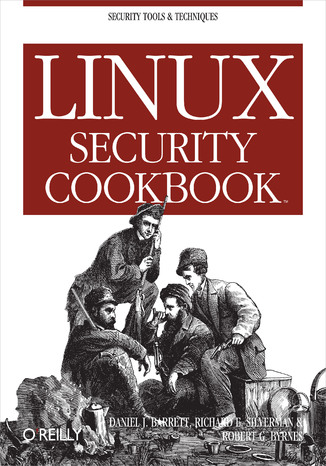



- Autorzy:
- Daniel J. Barrett, Richard E. Silverman, Robert G. Byrnes
- Ocena:
- Bądź pierwszym, który oceni tę książkę
- Stron:
- 336
- Dostępne formaty:
-
ePubMobi
Opis
książki
:
Linux Security Cookbook
Computer security is an ongoing process, a relentless contest between system administrators and intruders. A good administrator needs to stay one step ahead of any adversaries, which often involves a continuing process of education. If you're grounded in the basics of security, however, you won't necessarily want a complete treatise on the subject each time you pick up a book. Sometimes you want to get straight to the point. That's exactly what the new Linux Security Cookbook does. Rather than provide a total security solution for Linux computers, the authors present a series of easy-to-follow recipes--short, focused pieces of code that administrators can use to improve security and perform common tasks securely.The Linux Security Cookbook includes real solutions to a wide range of targeted problems, such as sending encrypted email within Emacs, restricting access to network services at particular times of day, firewalling a webserver, preventing IP spoofing, setting up key-based SSH authentication, and much more. With over 150 ready-to-use scripts and configuration files, this unique book helps administrators secure their systems without having to look up specific syntax. The book begins with recipes devised to establish a secure system, then moves on to secure day-to-day practices, and concludes with techniques to help your system stay secure.Some of the "recipes" you'll find in this book are:
- Controlling access to your system from firewalls down to individual services, using iptables, ipchains, xinetd, inetd, and more
- Monitoring your network with tcpdump, dsniff, netstat, and other tools
- Protecting network connections with Secure Shell (SSH) and stunnel
- Safeguarding email sessions with Secure Sockets Layer (SSL)
- Encrypting files and email messages with GnuPG
- Probing your own security with password crackers, nmap, and handy scripts
Wybrane bestsellery
-
Nowość Promocja
 Oddajemy Czytelnikowi nowe, zaktualizowane i uzupełnione wydanie książki prezentującej możliwości Kali Linux w zakresie testowania bezpieczeństwa oprogramowania. Poza opisem samego systemu i dostępnych narzędzi w wyczerpujący sposób przedstawiono tu szczegóły prowadzenia testów bezpieczeństwa, w tym sieci bezprzewodowych. Omówiono zasady testowania aplikacji WWW, techniki łamania haseł i korzystania z eksploitów. W tym wydaniu znalazły się również bezcenne wskazówki dotyczące analizy oprogramowania z wykorzystaniem inżynierii wstecznej i śledzenia nadużyć cyfrowych. Nie zabrakło też kluczowych dla każdego pentestera kwestii etyki i legalności podejmowanych działań.
Oddajemy Czytelnikowi nowe, zaktualizowane i uzupełnione wydanie książki prezentującej możliwości Kali Linux w zakresie testowania bezpieczeństwa oprogramowania. Poza opisem samego systemu i dostępnych narzędzi w wyczerpujący sposób przedstawiono tu szczegóły prowadzenia testów bezpieczeństwa, w tym sieci bezprzewodowych. Omówiono zasady testowania aplikacji WWW, techniki łamania haseł i korzystania z eksploitów. W tym wydaniu znalazły się również bezcenne wskazówki dotyczące analizy oprogramowania z wykorzystaniem inżynierii wstecznej i śledzenia nadużyć cyfrowych. Nie zabrakło też kluczowych dla każdego pentestera kwestii etyki i legalności podejmowanych działań.-
ebook
-
książka
59 pkt
(59,50 zł najniższa cena z 30 dni)
59.50 zł
119.00 zł (-50%) -
-
Promocja
 Deep Web to ogromna, ukryta część Internetu, która pozostaje niewidoczna dla tradycyjnych wyszukiwarek takich jak Google. Obejmuje zasoby nieindeksowane przez standardowe boty – bazy danych, repozytoria naukowe, archiwa statystyczne czy wyspecjalizowane wyszukiwarki branżowe. W przeciwieństwie do Dark Webu, Deep Web nie jest anonimową przestrzenią przestępczą, lecz miejscem dostępu do wartościowych i często darmowych informacji. Znajomość Deep Webu pozwala dotrzeć do wiarygodnych źródeł danych z zakresu demografii, zdrowia, edukacji, środowiska czy gospodarki. To również nieocenione narzędzie dla analityków, dziennikarzy, badaczy i osób podejmujących decyzje na podstawie twardych danych.
Deep Web to ogromna, ukryta część Internetu, która pozostaje niewidoczna dla tradycyjnych wyszukiwarek takich jak Google. Obejmuje zasoby nieindeksowane przez standardowe boty – bazy danych, repozytoria naukowe, archiwa statystyczne czy wyspecjalizowane wyszukiwarki branżowe. W przeciwieństwie do Dark Webu, Deep Web nie jest anonimową przestrzenią przestępczą, lecz miejscem dostępu do wartościowych i często darmowych informacji. Znajomość Deep Webu pozwala dotrzeć do wiarygodnych źródeł danych z zakresu demografii, zdrowia, edukacji, środowiska czy gospodarki. To również nieocenione narzędzie dla analityków, dziennikarzy, badaczy i osób podejmujących decyzje na podstawie twardych danych.-
kurs
44 pkt
(34,90 zł najniższa cena z 30 dni)
44.90 zł
199.00 zł (-77%) -
-
Promocja
 Cechą dzisiejszego rynku IT jest ciągła zmiana. Zmieniają się urządzenia, modyfikacjom podlega również software. Jedną z przyczyn wprowadzania kolejnych unowocześnień jest dążenie do utrzymania odpowiedniego poziomu świadczenia usług biznesowych i wysokiego poziomu bezpieczeństwa. Służy temu na przykład zastosowanie monitoringu infrastruktury, czyli użycie odpowiednich narzędzi weryfikujących stan sieci, serwerów czy też aplikacji.
Cechą dzisiejszego rynku IT jest ciągła zmiana. Zmieniają się urządzenia, modyfikacjom podlega również software. Jedną z przyczyn wprowadzania kolejnych unowocześnień jest dążenie do utrzymania odpowiedniego poziomu świadczenia usług biznesowych i wysokiego poziomu bezpieczeństwa. Służy temu na przykład zastosowanie monitoringu infrastruktury, czyli użycie odpowiednich narzędzi weryfikujących stan sieci, serwerów czy też aplikacji.-
ebook
-
książka
34 pkt
(34,50 zł najniższa cena z 30 dni)
34.50 zł
69.00 zł (-50%) -
-
Promocja
 W trakcie lektury tej książki przygotujesz własne laboratorium, a następnie przeanalizujesz każdy etap zabójczego łańcucha ataków i zastosujesz nową wiedzę w praktyce. Dowiesz się, jak ominąć wbudowane mechanizmy bezpieczeństwa, między innymi AMSI, AppLocker i Sysmon, przeprowadzać działania rozpoznawcze i wykrywające w środowisku domeny, a także zbierać dane uwierzytelniające w całej domenie. Przeczytasz również, jak poruszać się ruchem bocznym, aby wtopić się w ruch środowiska i pozostać niewykrytym przez radary obrońców, a ponadto jak eskalować uprawnienia wewnątrz domeny i w całym lesie domen czy osiągać stan przetrwania na poziomie domeny i w kontrolerze domeny. W efekcie nauczysz się przeprowadzać ocenę bezpieczeństwa różnych produktów i usług Microsoftu, takich jak Exchange Server, SQL Server i SCCM.
W trakcie lektury tej książki przygotujesz własne laboratorium, a następnie przeanalizujesz każdy etap zabójczego łańcucha ataków i zastosujesz nową wiedzę w praktyce. Dowiesz się, jak ominąć wbudowane mechanizmy bezpieczeństwa, między innymi AMSI, AppLocker i Sysmon, przeprowadzać działania rozpoznawcze i wykrywające w środowisku domeny, a także zbierać dane uwierzytelniające w całej domenie. Przeczytasz również, jak poruszać się ruchem bocznym, aby wtopić się w ruch środowiska i pozostać niewykrytym przez radary obrońców, a ponadto jak eskalować uprawnienia wewnątrz domeny i w całym lesie domen czy osiągać stan przetrwania na poziomie domeny i w kontrolerze domeny. W efekcie nauczysz się przeprowadzać ocenę bezpieczeństwa różnych produktów i usług Microsoftu, takich jak Exchange Server, SQL Server i SCCM.-
ebook
-
książka
44 pkt
(44,50 zł najniższa cena z 30 dni)
44.50 zł
89.00 zł (-50%) -
-
Promocja
 W świecie, w którym ataki hakerskie należą do codzienności, znajomość zasad cyberbezpieczeństwa to nie bonus, a prawdziwa tarcza. Ucząc się o cybersecurity, zyskujesz umiejętność czytania między wierszami danych i rozumienia, co się naprawdę dzieje „pod maską” sieci i systemów informatycznych. To nie jest tylko kwestia reagowania na zagrożenia, to zdolność przewidywania, wykrywania subtelnych sygnałów i zabezpieczania tego, co dla wielu pozostaje niewidoczne.
W świecie, w którym ataki hakerskie należą do codzienności, znajomość zasad cyberbezpieczeństwa to nie bonus, a prawdziwa tarcza. Ucząc się o cybersecurity, zyskujesz umiejętność czytania między wierszami danych i rozumienia, co się naprawdę dzieje „pod maską” sieci i systemów informatycznych. To nie jest tylko kwestia reagowania na zagrożenia, to zdolność przewidywania, wykrywania subtelnych sygnałów i zabezpieczania tego, co dla wielu pozostaje niewidoczne.-
kurs
44 pkt
(34,90 zł najniższa cena z 30 dni)
44.90 zł
199.00 zł (-77%) -
-
Promocja
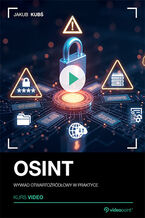 OSINT, czyli sztuka legalnego i etycznego pozyskiwania informacji z ogólnodostępnych źródeł takich jak Internet, media społecznościowe, fora czy dokumenty publiczne, to dziś jedna z najbardziej cenionych umiejętności w IT, dziennikarstwie śledczym i rekrutacji. Specjaliści potrafią szybko docierać do wartościowych danych o firmach, osobach, produktach czy wydarzeniach potrzebnych w analizie konkurencji, cyberbezpieczeństwie i obszarze compliance. Znajomość OSINT umożliwia lepsze podejmowanie decyzji, szybsze reagowanie na zagrożenia i skuteczne analizowanie informacji, co stanowi przewagę na rynku pracy. Dzięki tym kompetencjom możliwe jest weryfikowanie faktów, identyfikowanie fałszywych treści i wyciąganie trafnych wniosków z pozornie chaotycznych danych. Nauka białego wywiadu rozwija myślenie analityczne, uczy zadawania właściwych pytań i korzystania z zaawansowanych technik wyszukiwania. Umiejętności te można łączyć z innymi dziedzinami – technologicznymi, prawnymi czy społecznymi – co czyni OSINT wyjątkowo praktyczną i wszechstronną wiedzą. To także doskonała baza do dalszego rozwoju w kierunku cyberbezpieczeństwa, analizy danych czy cyfrowych śledztw. Dołącz do szkolenia i zdobądź kompetencje, które realnie zwiększą Twoją wartość zawodową – postaw na OSINT!
OSINT, czyli sztuka legalnego i etycznego pozyskiwania informacji z ogólnodostępnych źródeł takich jak Internet, media społecznościowe, fora czy dokumenty publiczne, to dziś jedna z najbardziej cenionych umiejętności w IT, dziennikarstwie śledczym i rekrutacji. Specjaliści potrafią szybko docierać do wartościowych danych o firmach, osobach, produktach czy wydarzeniach potrzebnych w analizie konkurencji, cyberbezpieczeństwie i obszarze compliance. Znajomość OSINT umożliwia lepsze podejmowanie decyzji, szybsze reagowanie na zagrożenia i skuteczne analizowanie informacji, co stanowi przewagę na rynku pracy. Dzięki tym kompetencjom możliwe jest weryfikowanie faktów, identyfikowanie fałszywych treści i wyciąganie trafnych wniosków z pozornie chaotycznych danych. Nauka białego wywiadu rozwija myślenie analityczne, uczy zadawania właściwych pytań i korzystania z zaawansowanych technik wyszukiwania. Umiejętności te można łączyć z innymi dziedzinami – technologicznymi, prawnymi czy społecznymi – co czyni OSINT wyjątkowo praktyczną i wszechstronną wiedzą. To także doskonała baza do dalszego rozwoju w kierunku cyberbezpieczeństwa, analizy danych czy cyfrowych śledztw. Dołącz do szkolenia i zdobądź kompetencje, które realnie zwiększą Twoją wartość zawodową – postaw na OSINT!-
kurs
44 pkt
(34,90 zł najniższa cena z 30 dni)
44.90 zł
129.00 zł (-65%) -
-
Promocja
 Umiejętność obrony przed atakami na aplikacje webowe jest dziś jedną z najważniejszych kompetencji w branży IT. Ofiarami cyberataków padają zarówno duże korporacje, jak i małe biznesy, a głównym celem hakerów jest pozyskanie danych wrażliwych. Dlatego skuteczne zabezpieczanie informacji użytkowników jest wyzwaniem, ale i podstawą w budowaniu zaufania do marki. W trakcie naszego szkolenia dowiesz się, jak działają popularne ataki – takie jak SQL Injection, XSS czy brute force – i nauczysz się im zapobiegać. Każda lekcja to konkretne przykłady, symulacje rzeczywistych ataków oraz analiza znanych podatności, dzięki czemu zdobytą wiedzę od razu zastosujesz w praktyce. Nawet bez wcześniejszego doświadczenia technicznego możesz szybko przyswoić umiejętności potrzebne do identyfikacji zagrożeń i ich neutralizacji. Zrozumienie działania aplikacji webowych od środka to klucz do tworzenia bezpieczniejszego kodu i projektowania odpornych systemów. Ten rodzaj kwalifikacji jest więc niezwykle przydatny nie tylko dla pentesterów, ale również dla developerów, DevOpsów i administratorów systemów. Co więcej, umiejętność pracy z profesjonalnymi narzędziami – takimi jak Burp Suite czy Gobuster – stanowi dziś duży atut i może znacząco wzmocnić Twoje CV. W świecie, w którym ataki są codziennością, inwestycja w cyberbezpieczeństwo szybko się zwraca, realnie zmniejszając ryzyko udanego ataku oraz związanych z nim strat finansowych.
Umiejętność obrony przed atakami na aplikacje webowe jest dziś jedną z najważniejszych kompetencji w branży IT. Ofiarami cyberataków padają zarówno duże korporacje, jak i małe biznesy, a głównym celem hakerów jest pozyskanie danych wrażliwych. Dlatego skuteczne zabezpieczanie informacji użytkowników jest wyzwaniem, ale i podstawą w budowaniu zaufania do marki. W trakcie naszego szkolenia dowiesz się, jak działają popularne ataki – takie jak SQL Injection, XSS czy brute force – i nauczysz się im zapobiegać. Każda lekcja to konkretne przykłady, symulacje rzeczywistych ataków oraz analiza znanych podatności, dzięki czemu zdobytą wiedzę od razu zastosujesz w praktyce. Nawet bez wcześniejszego doświadczenia technicznego możesz szybko przyswoić umiejętności potrzebne do identyfikacji zagrożeń i ich neutralizacji. Zrozumienie działania aplikacji webowych od środka to klucz do tworzenia bezpieczniejszego kodu i projektowania odpornych systemów. Ten rodzaj kwalifikacji jest więc niezwykle przydatny nie tylko dla pentesterów, ale również dla developerów, DevOpsów i administratorów systemów. Co więcej, umiejętność pracy z profesjonalnymi narzędziami – takimi jak Burp Suite czy Gobuster – stanowi dziś duży atut i może znacząco wzmocnić Twoje CV. W świecie, w którym ataki są codziennością, inwestycja w cyberbezpieczeństwo szybko się zwraca, realnie zmniejszając ryzyko udanego ataku oraz związanych z nim strat finansowych.-
kurs
44 pkt
(34,90 zł najniższa cena z 30 dni)
44.90 zł
119.00 zł (-62%) -
-
Promocja
 Z tą książką krok po kroku zagłębisz się w metody OSINT, a także powiązane z nim zagadnienia natury prawnej i etycznej. Poznasz sposoby gromadzenia i analizowania informacji z wykorzystaniem wyszukiwarek, portali społecznościowych i innych zasobów internetowych. Zrozumiesz wagę anonimowości i technik gwarantujących bezpieczne poruszanie się po sieci, ułatwiających zarządzanie cyfrowym śladem czy tworzenie fikcyjnych tożsamości internetowych. Zdobędziesz również doświadczenie w korzystaniu z popularnych narzędzi OSINT, takich jak Recon-ng, Maltego, Shodan czy Aircrack-ng. Dowiesz się też, jak ograniczać ryzyko, przewidywać cyberataki, zapobiegać im i na nie reagować — wszystko dzięki technikom opartym na OSINT.
Z tą książką krok po kroku zagłębisz się w metody OSINT, a także powiązane z nim zagadnienia natury prawnej i etycznej. Poznasz sposoby gromadzenia i analizowania informacji z wykorzystaniem wyszukiwarek, portali społecznościowych i innych zasobów internetowych. Zrozumiesz wagę anonimowości i technik gwarantujących bezpieczne poruszanie się po sieci, ułatwiających zarządzanie cyfrowym śladem czy tworzenie fikcyjnych tożsamości internetowych. Zdobędziesz również doświadczenie w korzystaniu z popularnych narzędzi OSINT, takich jak Recon-ng, Maltego, Shodan czy Aircrack-ng. Dowiesz się też, jak ograniczać ryzyko, przewidywać cyberataki, zapobiegać im i na nie reagować — wszystko dzięki technikom opartym na OSINT.-
ebook
-
książka
33 pkt
(33,50 zł najniższa cena z 30 dni)
33.50 zł
67.00 zł (-50%) -
-
Promocja
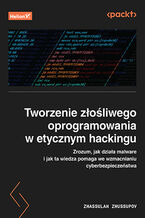 Ta książka jest kompleksowym przewodnikiem po ciemnej stronie cyberbezpieczeństwa ― zapewni Ci wiedzę i umiejętności niezbędne do skutecznego zwalczania złośliwego oprogramowania. Nauczysz się poruszać wśród zawiłości związanych z tworzeniem złośliwego oprogramowania, a także dobrze poznasz techniki i strategie stosowane przez cyberprzestępców. Zdobędziesz też praktyczne doświadczenie w projektowaniu i implementowaniu popularnych rozwiązań stosowanych w prawdziwych złośliwych aplikacjach, na przykład Carbanak, Carberp, Stuxnet, Conti, Babuk i BlackCat. Nie zabrakło tu zasad etycznego hakingu i tajników budowy złośliwego oprogramowania, jak techniki unikania wykrycia, mechanizmy persystencji i wiele innych, które poznasz dzięki lekturze.
Ta książka jest kompleksowym przewodnikiem po ciemnej stronie cyberbezpieczeństwa ― zapewni Ci wiedzę i umiejętności niezbędne do skutecznego zwalczania złośliwego oprogramowania. Nauczysz się poruszać wśród zawiłości związanych z tworzeniem złośliwego oprogramowania, a także dobrze poznasz techniki i strategie stosowane przez cyberprzestępców. Zdobędziesz też praktyczne doświadczenie w projektowaniu i implementowaniu popularnych rozwiązań stosowanych w prawdziwych złośliwych aplikacjach, na przykład Carbanak, Carberp, Stuxnet, Conti, Babuk i BlackCat. Nie zabrakło tu zasad etycznego hakingu i tajników budowy złośliwego oprogramowania, jak techniki unikania wykrycia, mechanizmy persystencji i wiele innych, które poznasz dzięki lekturze.-
ebook
-
książka
44 pkt
(44,50 zł najniższa cena z 30 dni)
44.50 zł
89.00 zł (-50%) -
-
Promocja
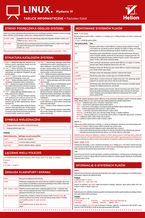 Jeśli używasz systemu operacyjnego Linux, tablice informatyczne są Ci niezbędnie potrzebne. Znajdziesz w nich najważniejsze informacje dotyczące katalogów i poleceń — od dotyczących struktury katalogów systemu, przez dotyczące symboli wieloznacznych, łączenia poleceń, obsługi klawiatury i ekranu, aż po te o systemach plików. Przypomnisz sobie, jak nawigować pomiędzy katalogami i wyświetlać ich zawartość, tworzyć i usuwać pliki oraz nimi zarządzać, wyszukiwać je i archiwizować.
Jeśli używasz systemu operacyjnego Linux, tablice informatyczne są Ci niezbędnie potrzebne. Znajdziesz w nich najważniejsze informacje dotyczące katalogów i poleceń — od dotyczących struktury katalogów systemu, przez dotyczące symboli wieloznacznych, łączenia poleceń, obsługi klawiatury i ekranu, aż po te o systemach plików. Przypomnisz sobie, jak nawigować pomiędzy katalogami i wyświetlać ich zawartość, tworzyć i usuwać pliki oraz nimi zarządzać, wyszukiwać je i archiwizować.-
ebook
-
książka
8 pkt
(8,49 zł najniższa cena z 30 dni)
8.49 zł
17.00 zł (-50%) -
O autorze książki
Dr Daniel J. Barrett jest inżynierem oprogramowania, administratorem systemów, muzykiem i satyrykiem. Od wczesnych lat 90. XX wieku pisze o technologiach informatycznych. Dla wydawnictwa O’Reilly napisał wiele książek, między innymi: SSH, Secure Shell: The Definitive Guide, MediaWiki i Linux. Bezpieczeństwo. Receptury.
Daniel J. Barrett, Richard E. Silverman, Robert G. Byrnes - pozostałe książki
-
Promocja
 Take your Linux skills to the next level! Whether you're a system administrator, software developer, site reliability engineer, or enthusiastic hobbyist, this practical, hands-on book will help you work faster, smarter, and more efficiently. You'll learn how to create and run complex commands that solve real business problems, process and retrieve
Take your Linux skills to the next level! Whether you're a system administrator, software developer, site reliability engineer, or enthusiastic hobbyist, this practical, hands-on book will help you work faster, smarter, and more efficiently. You'll learn how to create and run complex commands that solve real business problems, process and retrieve-
-
ebook
160 pkt
(29,90 zł najniższa cena z 30 dni)
160.65 zł
189.00 zł (-15%) -
-
Promocja
 Niniejsza książka jest zwięzłym przewodnikiem po systemie. Docenią ją zarówno początkujący, jak i zaawansowani użytkownicy. Opisano tu ważne i użyteczne aspekty Linuksa, tak aby każdy szybko mógł rozpocząć efektywną pracę. W tym wydaniu książki pojawiły się również nowe polecenia służące do przetwarzania plików audiowizualnych, odczytywania i zapisywania zawartości schowka systemowego oraz do wykonywania operacji na plikach PDF. Nie pominięto też idiomów powłoki, takich jak podstawianie poleceń czy przekazywanie ich potokiem do powłoki.
Niniejsza książka jest zwięzłym przewodnikiem po systemie. Docenią ją zarówno początkujący, jak i zaawansowani użytkownicy. Opisano tu ważne i użyteczne aspekty Linuksa, tak aby każdy szybko mógł rozpocząć efektywną pracę. W tym wydaniu książki pojawiły się również nowe polecenia służące do przetwarzania plików audiowizualnych, odczytywania i zapisywania zawartości schowka systemowego oraz do wykonywania operacji na plikach PDF. Nie pominięto też idiomów powłoki, takich jak podstawianie poleceń czy przekazywanie ich potokiem do powłoki.-
ebook
-
książka
14 pkt
(14,95 zł najniższa cena z 30 dni)
14.95 zł
29.90 zł (-50%) -
-
Promocja
 „Linux. Leksykon kieszonkowy” to książka dla tych, których do Linuksa zniechęca konieczność zapamiętania niezliczonej ilości poleceń i parametrów, oraz dla tych, którzy pracują z nim na co dzień i potrzebują podręcznej ściągi. Znajdziesz tu zestawienie poleceń najczęściej używanych w codziennej pracy. Ponadto dowiesz się, jak dopasować system do własnych potrzeb oraz jak programować skrypty powłoki. W trakcie lektury przekonasz się, że wiele zadań szybciej wykonasz w trybie tekstowym niż graficznym. Książka ta jest nieocenionym pomocnikiem każdego użytkownika systemu Linux, dlatego warto mieć ją pod ręką!
„Linux. Leksykon kieszonkowy” to książka dla tych, których do Linuksa zniechęca konieczność zapamiętania niezliczonej ilości poleceń i parametrów, oraz dla tych, którzy pracują z nim na co dzień i potrzebują podręcznej ściągi. Znajdziesz tu zestawienie poleceń najczęściej używanych w codziennej pracy. Ponadto dowiesz się, jak dopasować system do własnych potrzeb oraz jak programować skrypty powłoki. W trakcie lektury przekonasz się, że wiele zadań szybciej wykonasz w trybie tekstowym niż graficznym. Książka ta jest nieocenionym pomocnikiem każdego użytkownika systemu Linux, dlatego warto mieć ją pod ręką!-
ebook
-
książka
12 pkt
(12,45 zł najniższa cena z 30 dni)
12.45 zł
24.90 zł (-50%) -
-
Promocja
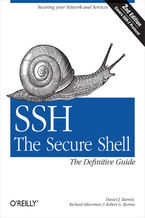 Are you serious about network security? Then check out SSH, the Secure Shell, which provides key-based authentication and transparent encryption for your network connections. It's reliable, robust, and reasonably easy to use, and both free and commercial implementations are widely available for most operating systems. While it doesn't solve every p
Are you serious about network security? Then check out SSH, the Secure Shell, which provides key-based authentication and transparent encryption for your network connections. It's reliable, robust, and reasonably easy to use, and both free and commercial implementations are widely available for most operating systems. While it doesn't solve every p-
-
ebook
118 pkt
(29,90 zł najniższa cena z 30 dni)
118.15 zł
139.00 zł (-15%) -
-
Promocja
 Książka "Linux. Bezpieczeństwo. Przewodnik encyklopedyczny" nauczy Cię, jakie polecenia należy wykonać i co wpisać w plikach konfiguracyjnych, by poprawić bezpieczeństwo Twojego systemu. Nie jest to klasyczny podręcznik; nie znajdziesz tu teorii, lecz rozwiązania konkretnych problemów i sposoby łatania typowych luk w zabezpieczeniach. Dzięki książce nie będziesz tracić cennego czasu, poszukując właściwej składni poleceń. Przeznaczona jest dla średnio zaawansowanych użytkowników i administratorów systemów Linux.
Książka "Linux. Bezpieczeństwo. Przewodnik encyklopedyczny" nauczy Cię, jakie polecenia należy wykonać i co wpisać w plikach konfiguracyjnych, by poprawić bezpieczeństwo Twojego systemu. Nie jest to klasyczny podręcznik; nie znajdziesz tu teorii, lecz rozwiązania konkretnych problemów i sposoby łatania typowych luk w zabezpieczeniach. Dzięki książce nie będziesz tracić cennego czasu, poszukując właściwej składni poleceń. Przeznaczona jest dla średnio zaawansowanych użytkowników i administratorów systemów Linux.-
książka
44 pkt
(44,85 zł najniższa cena z 30 dni)
44.85 zł
69.00 zł (-35%) -
-
Promocja
 Today's software applications need more than a friendly interface and correct algorithms. They also need to be responsible: to be beneficial for society and not cause harm. In an era of AI chatbots, deep fake images and videos, social media bubbles, expanding privacy regulations, and a warming planet, it's more important than ever to practice respo
Today's software applications need more than a friendly interface and correct algorithms. They also need to be responsible: to be beneficial for society and not cause harm. In an era of AI chatbots, deep fake images and videos, social media bubbles, expanding privacy regulations, and a warming planet, it's more important than ever to practice respo-
-
ebook
169 pkt
(29,90 zł najniższa cena z 30 dni)
169.14 zł
199.00 zł (-15%) -
-
Promocja
 Administratorzy systemów linuksowych mogą pracować za pomocą myszy, korzystając z interfejsu graficznego, jednak pełny potencjał Linuksa ujawnia się dzięki pracy z wierszem poleceń. Umiejętność używania tego narzędzia przydaje się każdemu, komu zależy na efektywnym działaniu systemu.
Administratorzy systemów linuksowych mogą pracować za pomocą myszy, korzystając z interfejsu graficznego, jednak pełny potencjał Linuksa ujawnia się dzięki pracy z wierszem poleceń. Umiejętność używania tego narzędzia przydaje się każdemu, komu zależy na efektywnym działaniu systemu.-
ebook
-
książka
29 pkt
(29,95 zł najniższa cena z 30 dni)
29.95 zł
59.90 zł (-50%) -
-
Promocja
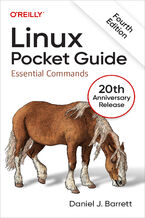 If you use Linux in your day-to-day work, then Linux Pocket Guide is the perfect on-the-job reference. This thoroughly updated 20th anniversary edition explains more than 200 Linux commands, including new commands for file handling, package management, version control, file format conversions, and more.In this concise guide, author Daniel Barrett p
If you use Linux in your day-to-day work, then Linux Pocket Guide is the perfect on-the-job reference. This thoroughly updated 20th anniversary edition explains more than 200 Linux commands, including new commands for file handling, package management, version control, file format conversions, and more.In this concise guide, author Daniel Barrett p-
-
ebook
84 pkt
(29,90 zł najniższa cena z 30 dni)
84.92 zł
99.90 zł (-15%) -
Kup polskie wydanie:
Ebooka "Linux Security Cookbook" przeczytasz na:
-
czytnikach Inkbook, Kindle, Pocketbook, Onyx Boox i innych
-
systemach Windows, MacOS i innych
-
systemach Windows, Android, iOS, HarmonyOS
-
na dowolnych urządzeniach i aplikacjach obsługujących formaty: PDF, EPub, Mobi
Masz pytania? Zajrzyj do zakładki Pomoc »
Szczegóły książki
- ISBN Ebooka:
- 978-14-493-6676-6, 9781449366766
- Data wydania ebooka :
-
2003-06-02
 Data wydania ebooka często jest dniem wprowadzenia tytułu do sprzedaży i może nie być równoznaczna
z datą wydania książki papierowej. Dodatkowe informacje możesz znaleźć w darmowym fragmencie.
Jeśli masz wątpliwości skontaktuj się z nami sklep@ebookpoint.pl.
Data wydania ebooka często jest dniem wprowadzenia tytułu do sprzedaży i może nie być równoznaczna
z datą wydania książki papierowej. Dodatkowe informacje możesz znaleźć w darmowym fragmencie.
Jeśli masz wątpliwości skontaktuj się z nami sklep@ebookpoint.pl.
- Język publikacji:
- angielski
- Rozmiar pliku ePub:
- 1.6MB
- Rozmiar pliku Mobi:
- 4.5MB
Dostępność produktu
Produkt nie został jeszcze oceniony pod kątem ułatwień dostępu lub nie podano żadnych informacji o ułatwieniach dostępu lub są one niewystarczające. Prawdopodobnie Wydawca/Dostawca jeszcze nie umożliwił dokonania walidacji produktu lub nie przekazał odpowiednich informacji na temat jego dostępności.
Spis treści książki
- Linux Security Cookbook
- Preface
- A Cookbook About Security?!?
- Intended Audience
- Roadmap of the Book
- Our Security Philosophy
- Supported Linux Distributions
- Trying the Recipes
- Conventions Used in This Book
- Wed Like to Hear from You
- Acknowledgments
- 1. System Snapshots with Tripwire
- 1.1. Setting Up Tripwire
- 1.1.1. Problem
- 1.1.2. Solution
- 1.1.3. Discussion
- 1.1.4. See Also
- 1.2. Displaying the Policy and Configuration
- 1.2.1. Problem
- 1.2.2. Solution
- 1.2.3. Discussion
- 1.2.4. See Also
- 1.3. Modifying the Policy and Configuration
- 1.3.1. Problem
- 1.3.2. Solution
- 1.3.3. Discussion
- 1.3.4. See Also
- 1.4. Basic Integrity Checking
- 1.4.1. Problem
- 1.4.2. Solution
- 1.4.3. Discussion
- 1.4.4. See Also
- 1.5. Read-Only Integrity Checking
- 1.5.1. Problem
- 1.5.2. Solution
- 1.5.3. Discussion
- 1.5.4. See Also
- 1.6. Remote Integrity Checking
- 1.6.1. Problem
- 1.6.2. Solution
- 1.6.3. Discussion
- 1.6.4. See Also
- 1.7. Ultra-Paranoid Integrity Checking
- 1.7.1. Problem
- 1.7.2. Solution
- 1.7.3. Discussion
- 1.7.4. See Also
- 1.8. Expensive, Ultra-Paranoid Security Checking
- 1.8.1. Problem
- 1.8.2. Solution
- 1.8.3. Discussion
- 1.9. Automated Integrity Checking
- 1.9.1. Problem
- 1.9.2. Solution
- 1.9.3. Discussion
- 1.9.4. See Also
- 1.10. Printing the Latest Tripwire Report
- 1.10.1. Problem
- 1.10.2. Solution
- 1.10.3. Discussion
- 1.10.4. See Also
- 1.11. Updating the Database
- 1.11.1. Problem
- 1.11.2. Solution
- 1.11.3. Discussion
- 1.11.4. See Also
- 1.12. Adding Files to the Database
- 1.12.1. Problem
- 1.12.2. Solution
- 1.12.3. Discussion
- 1.12.4. See Also
- 1.13. Excluding Files from the Database
- 1.13.1. Problem
- 1.13.2. Solution
- 1.13.3. Discussion
- 1.13.4. See Also
- 1.14. Checking Windows VFAT Filesystems
- 1.14.1. Problem
- 1.14.2. Solution
- 1.14.3. Discussion
- 1.14.4. See Also
- 1.15. Verifying RPM-Installed Files
- 1.15.1. Problem
- 1.15.2. Solution
- 1.15.3. Discussion
- 1.15.4. See Also
- 1.16. Integrity Checking with rsync
- 1.16.1. Problem
- 1.16.2. Solution
- 1.16.3. Discussion
- 1.16.4. See Also
- 1.17. Integrity Checking Manually
- 1.17.1. Problem
- 1.17.2. Solution
- 1.17.3. Discussion
- 1.17.4. See Also
- 1.1. Setting Up Tripwire
- 2. Firewalls with iptables and ipchains
- 2.1. Enabling Source Address Verification
- 2.1.1. Problem
- 2.1.2. Solution
- 2.1.3. Discussion
- 2.1.4. See Also
- 2.2. Blocking Spoofed Addresses
- 2.2.1. Problem
- 2.2.2. Solution
- 2.2.3. Discussion
- 2.2.4. See Also
- 2.3. Blocking All Network Traffic
- 2.3.1. Problem
- 2.3.2. Solution
- 2.3.3. Discussion
- 2.3.4. See Also
- 2.4. Blocking Incoming Traffic
- 2.4.1. Problem
- 2.4.2. Solution
- 2.4.3. Discussion
- 2.4.4. See Also
- 2.5. Blocking Outgoing Traffic
- 2.5.1. Problem
- 2.5.2. Solution
- 2.5.3. Discussion
- 2.5.4. See Also
- 2.6. Blocking Incoming Service Requests
- 2.6.1. Problem
- 2.6.2. Solution
- 2.6.3. Discussion
- 2.6.4. See Also
- 2.7. Blocking Access from a Remote Host
- 2.7.1. Problem
- 2.7.2. Solution
- 2.7.3. Discussion
- 2.7.4. See Also
- 2.8. Blocking Access to a Remote Host
- 2.8.1. Problem
- 2.8.2. Solution
- 2.8.3. Discussion
- 2.8.4. See Also
- 2.9. Blocking Outgoing Access to All Web Servers on a Network
- 2.9.1. Problem
- 2.9.2. Solution
- 2.9.3. Discussion
- 2.9.4. See Also
- 2.10. Blocking Remote Access, but Permitting Local
- 2.10.1. Problem
- 2.10.2. Solution
- 2.10.3. Discussion
- 2.10.4. See Also
- 2.11. Controlling Access by MAC Address
- 2.11.1. Problem
- 2.11.2. Solution
- 2.11.3. Discussion
- 2.11.4. See Also
- 2.12. Permitting SSH Access Only
- 2.12.1. Problem
- 2.12.2. Solution
- 2.12.3. Discussion
- 2.12.4. See Also
- 2.13. Prohibiting Outgoing Telnet Connections
- 2.13.1. Problem
- 2.13.2. Solution
- 2.13.3. Discussion
- 2.13.4. See Also
- 2.14. Protecting a Dedicated Server
- 2.14.1. Problem
- 2.14.2. Solution
- 2.14.3. Discussion
- 2.14.4. See Also
- 2.15. Preventing pings
- 2.15.1. Problem
- 2.15.2. Solution
- 2.15.3. Discussion
- 2.15.4. See Also
- 2.16. Listing Your Firewall Rules
- 2.16.1. Problem
- 2.16.2. Solution
- 2.16.3. Discussion
- 2.16.4. See Also
- 2.17. Deleting Firewall Rules
- 2.17.1. Problem
- 2.17.2. Solution
- 2.17.3. Discussion
- 2.17.4. See Also
- 2.18. Inserting Firewall Rules
- 2.18.1. Problem
- 2.18.2. Solution
- 2.18.3. Discussion
- 2.18.4. See Also
- 2.19. Saving a Firewall Configuration
- 2.19.1. Problem
- 2.19.2. Solution
- 2.19.3. Discussion
- 2.19.4. See Also
- 2.20. Loading a Firewall Configuration
- 2.20.1. Problem
- 2.20.2. Solution
- 2.20.3. Discussion
- 2.20.4. See Also
- 2.21. Testing a Firewall Configuration
- 2.21.1. Problem
- 2.21.2. Solution
- 2.21.3. Discussion
- 2.21.4. See Also
- 2.22. Building Complex Rule Trees
- 2.22.1. Problem
- 2.22.2. Solution
- 2.22.3. Discussion
- 2.22.4. See Also
- 2.23. Logging Simplified
- 2.23.1. Problem
- 2.23.2. Solution
- 2.23.3. Discussion
- 2.23.4. See Also
- 2.1. Enabling Source Address Verification
- 3. Network Access Control
- 3.1. Listing Your Network Interfaces
- 3.1.1. Problem
- 3.1.2. Solution
- 3.1.3. Discussion
- 3.1.4. See Also
- 3.2. Starting and Stopping the Network Interface
- 3.2.1. Problem
- 3.2.2. Solution
- 3.2.3. Discussion
- 3.2.4. See Also
- 3.3. Enabling/Disabling a Service (xinetd)
- 3.3.1. Problem
- 3.3.2. Solution
- 3.3.3. Discussion
- 3.3.4. See Also
- 3.4. Enabling/Disabling a Service (inetd)
- 3.4.1. Problem
- 3.4.2. Solution
- 3.4.3. Discussion
- 3.4.4. See Also
- 3.5. Adding a New Service (xinetd)
- 3.5.1. Problem
- 3.5.2. Solution
- 3.5.3. Discussion
- 3.5.4. See Also
- 3.6. Adding a New Service (inetd)
- 3.6.1. Problem
- 3.6.2. Solution
- 3.6.3. Discussion
- 3.6.4. See Also
- 3.7. Restricting Access by Remote Users
- 3.7.1. Problem
- 3.7.2. Solution
- 3.7.3. Discussion
- 3.7.4. See Also
- 3.8. Restricting Access by Remote Hosts (xinetd)
- 3.8.1. Problem
- 3.8.2. Solution
- 3.8.3. Discussion
- 3.8.4. See Also
- 3.9. Restricting Access by Remote Hosts (xinetd with libwrap)
- 3.9.1. Problem
- 3.9.2. Solution
- 3.9.3. Discussion
- 3.9.4. See Also
- 3.10. Restricting Access by Remote Hosts (xinetd with tcpd)
- 3.10.1. Problem
- 3.10.2. Solution
- 3.10.3. Discussion
- 3.10.4. See Also
- 3.11. Restricting Access by Remote Hosts (inetd)
- 3.11.1. Problem
- 3.11.2. Solution
- 3.11.3. Discussion
- 3.11.4. See Also
- 3.12. Restricting Access by Time of Day
- 3.12.1. Problem
- 3.12.2. Solution
- 3.12.3. Discussion
- 3.12.4. See Also
- 3.13. Restricting Access to an SSH Server by Host
- 3.13.1. Problem
- 3.13.2. Solution
- 3.13.3. Discussion
- 3.13.4. See Also
- 3.14. Restricting Access to an SSH Server by Account
- 3.14.1. Problem
- 3.14.2. Solution
- 3.14.3. Discussion
- 3.14.4. See Also
- 3.15. Restricting Services to Specific Filesystem Directories
- 3.15.1. Problem
- 3.15.2. Solution
- 3.15.3. Discussion
- 3.15.4. See Also
- 3.16. Preventing Denial of Service Attacks
- 3.16.1. Problem
- 3.16.2. Solution
- 3.16.3. Discussion
- 3.16.4. See Also
- 3.17. Redirecting to Another Socket
- 3.17.1. Problem
- 3.17.2. Solution
- 3.17.3. Discussion
- 3.17.4. See Also
- 3.18. Logging Access to Your Services
- 3.18.1. Problem
- 3.18.2. Solution
- 3.18.3. Discussion
- 3.18.4. See Also
- 3.19. Prohibiting root Logins on Terminal Devices
- 3.19.1. Problem
- 3.19.2. Solution
- 3.19.3. Discussion
- 3.19.4. See Also
- 3.1. Listing Your Network Interfaces
- 4. Authentication Techniques and Infrastructures
- 4.1. Creating a PAM-Aware Application
- 4.1.1. Problem
- 4.1.2. Solution
- 4.1.3. Discussion
- 4.1.4. See Also
- 4.2. Enforcing Password Strength with PAM
- 4.2.1. Problem
- 4.2.2. Solution
- 4.2.3. Discussion
- 4.2.4. See Also
- 4.3. Creating Access Control Lists with PAM
- 4.3.1. Problem
- 4.3.2. Solution
- 4.3.3. Discussion
- 4.3.4. See Also
- 4.4. Validating an SSL Certificate
- 4.4.1. Problem
- 4.4.2. Solution
- 4.4.3. Discussion
- 4.4.4. See Also
- 4.5. Decoding an SSL Certificate
- 4.5.1. Problem
- 4.5.2. Solution
- 4.5.3. Discussion
- 4.5.4. See Also
- 4.6. Installing a New SSL Certificate
- 4.6.1. Problem
- 4.6.2. Solution
- 4.6.3. Discussion
- 4.6.4. See Also
- 4.7. Generating an SSL Certificate Signing Request (CSR)
- 4.7.1. Problem
- 4.7.2. Solution
- 4.7.3. Discussion
- 4.7.4. See Also
- 4.8. Creating a Self-Signed SSL Certificate
- 4.8.1. Problem
- 4.8.2. Solution
- 4.8.3. Discussion
- 4.8.4. See Also
- 4.9. Setting Up a Certifying Authority
- 4.9.1. Problem
- 4.9.2. Solution
- 4.9.3. Discussion
- 4.9.4. See Also
- 4.10. Converting SSL Certificates from DER to PEM
- 4.10.1. Problem
- 4.10.2. Solution
- 4.10.3. Discussion
- 4.10.4. See Also
- 4.11. Getting Started with Kerberos
- 4.11.1. Problem
- 4.11.2. Solution
- 4.11.3. Discussion
- 4.11.4. See Also
- 4.12. Adding Users to a Kerberos Realm
- 4.12.1. Problem
- 4.12.2. Solution
- 4.12.3. Discussion
- 4.12.4. See Also
- 4.13. Adding Hosts to a Kerberos Realm
- 4.13.1. Problem
- 4.13.2. Solution
- 4.13.3. Discussion
- 4.13.4. See Also
- 4.14. Using Kerberos with SSH
- 4.14.1. Problem
- 4.14.2. Solution
- 4.14.3. Discussion
- 4.14.4. See Also
- 4.15. Using Kerberos with Telnet
- 4.15.1. Problem
- 4.15.2. Solution
- 4.15.3. Discussion
- 4.15.4. See Also
- 4.16. Securing IMAP with Kerberos
- 4.16.1. Problem
- 4.16.2. Solution
- 4.16.3. Discussion
- 4.16.4. See Also
- 4.17. Using Kerberos with PAM for System-Wide Authentication
- 4.17.1. Problem
- 4.17.2. Solution
- 4.17.3. Discussion
- 4.17.4. See Also
- 4.1. Creating a PAM-Aware Application
- 5. Authorization Controls
- 5.1. Running a root Login Shell
- 5.1.1. Problem
- 5.1.2. Solution
- 5.1.3. Discussion
- 5.1.4. See Also
- 5.2. Running X Programs as root
- 5.2.1. Problem
- 5.2.2. Solution
- 5.2.3. Discussion
- 5.2.4. See Also
- 5.3. Running Commands as Another User via sudo
- 5.3.1. Problem
- 5.3.2. Solution
- 5.3.3. Discussion
- 5.3.4. See Also
- 5.4. Bypassing Password Authentication in sudo
- 5.4.1. Problem
- 5.4.2. Solution
- 5.4.3. Discussion
- 5.4.4. See Also
- 5.5. Forcing Password Authentication in sudo
- 5.5.1. Problem
- 5.5.2. Solution
- 5.5.3. Discussion
- 5.5.4. See Also
- 5.6. Authorizing per Host in sudo
- 5.6.1. Problem
- 5.6.2. Solution
- 5.6.3. Discussion
- 5.6.4. See Also
- 5.7. Granting Privileges to a Group via sudo
- 5.7.1. Problem
- 5.7.2. Solution
- 5.7.3. See Also
- 5.8. Running Any Program in a Directory via sudo
- 5.8.1. Problem
- 5.8.2. Solution
- 5.8.3. See Also
- 5.9. Prohibiting Command Arguments with sudo
- 5.9.1. Problem
- 5.9.2. Solution
- 5.9.3. Discussion
- 5.9.4. See Also
- 5.10. Sharing Files Using Groups
- 5.10.1. Problem
- 5.10.2. Solution
- 5.10.3. Discussion
- 5.10.4. See Also
- 5.11. Permitting Read-Only Access to a Shared File via sudo
- 5.11.1. Problem
- 5.11.2. Solution
- 5.11.3. Discussion
- 5.11.4. See Also
- 5.12. Authorizing Password Changes via sudo
- 5.12.1. Problem
- 5.12.2. Solution
- 5.12.3. Discussion
- 5.12.4. See Also
- 5.13. Starting/Stopping Daemons via sudo
- 5.13.1. Problem
- 5.13.2. Solution
- 5.13.3. Discussion
- 5.13.4. See Also
- 5.14. Restricting roots Abilities via sudo
- 5.14.1. Problem
- 5.14.2. Solution
- 5.14.3. Discussion
- 5.14.4. See Also
- 5.15. Killing Processes via sudo
- 5.15.1. Problem
- 5.15.2. Solution
- 5.15.3. Discussion
- 5.15.4. See Also
- 5.16. Listing sudo Invocations
- 5.16.1. Problem
- 5.16.2. Solution
- 5.16.3. Discussion
- 5.16.4. See Also
- 5.17. Logging sudo Remotely
- 5.17.1. Problem
- 5.17.2. Solution
- 5.17.3. Discussion
- 5.17.4. See Also
- 5.18. Sharing root Privileges via SSH
- 5.18.1. Problem
- 5.18.2. Solution
- 5.18.3. Discussion
- 5.18.4. See Also
- 5.19. Running root Commands via SSH
- 5.19.1. Problem
- 5.19.2. Solution
- 5.19.3. Discussion
- 5.19.4. See Also
- 5.20. Sharing root Privileges via Kerberos su
- 5.20.1. Problem
- 5.20.2. Solution
- 5.20.3. Discussion
- 5.20.3.1. Authentication
- 5.20.3.2. Authorization
- 5.20.4. See Also
- 5.1. Running a root Login Shell
- 6. Protecting Outgoing Network Connections
- 6.1. Logging into a Remote Host
- 6.1.1. Problem
- 6.1.2. Solution
- 6.1.3. Discussion
- 6.1.4. See Also
- 6.2. Invoking Remote Programs
- 6.2.1. Problem
- 6.2.2. Solution
- 6.2.3. Discussion
- 6.2.4. See Also
- 6.3. Copying Files Remotely
- 6.3.1. Problem
- 6.3.2. Solution
- 6.3.3. Discussion
- 6.3.4. See Also
- 6.4. Authenticating by Public Key (OpenSSH)
- 6.4.1. Problem
- 6.4.2. Solution
- 6.4.3. Discussion
- 6.4.4. See Also
- 6.5. Authenticating by Public Key (OpenSSH Client, SSH2 Server, OpenSSH Key)
- 6.5.1. Problem
- 6.5.2. Solution
- 6.5.3. Discussion
- 6.5.4. See Also
- 6.6. Authenticating by Public Key (OpenSSH Client, SSH2 Server, SSH2 Key)
- 6.6.1. Problem
- 6.6.2. Solution
- 6.6.3. Discussion
- 6.6.4. See Also
- 6.7. Authenticating by Public Key (SSH2 Client, OpenSSH Server)
- 6.7.1. Problem
- 6.7.2. Solution
- 6.7.3. Description
- 6.7.4. See Also
- 6.8. Authenticating by Trusted Host
- 6.8.1. Problem
- 6.8.2. Solution
- 6.8.3. Discussion
- 6.8.4. See Also
- 6.9. Authenticating Without a Password (Interactively)
- 6.9.1. Problem
- 6.9.2. Solution
- 6.9.3. Discussion
- 6.9.4. See Also
- 6.10. Authenticating in cron Jobs
- 6.10.1. Problem
- 6.10.2. Solution
- 6.10.3. Discussion
- 6.10.4. See Also
- 6.11. Terminating an SSH Agent on Logout
- 6.11.1. Problem
- 6.11.2. Solution
- 6.11.3. Discussion
- 6.11.4. See Also
- 6.12. Tailoring SSH per Host
- 6.12.1. Problem
- 6.12.2. Solution
- 6.12.3. Discussion
- 6.12.4. See Also
- 6.13. Changing SSH Client Defaults
- 6.13.1. Problem
- 6.13.2. Solution
- 6.13.3. Discussion
- 6.13.4. See Also
- 6.14. Tunneling Another TCP Session Through SSH
- 6.14.1. Problem
- 6.14.2. Solution
- 6.14.3. Discussion
- 6.14.4. See Also
- 6.15. Keeping Track of Passwords
- 6.15.1. Problem
- 6.15.2. Solution
- 6.15.3. Discussion
- 6.15.4. See Also
- 6.1. Logging into a Remote Host
- 7. Protecting Files
- 7.1. Using File Permissions
- 7.1.1. Problem
- 7.1.2. Solution
- 7.1.3. Discussion
- 7.1.4. See Also
- 7.2. Securing a Shared Directory
- 7.2.1. Problem
- 7.2.2. Solution
- 7.2.3. Discussion
- 7.2.4. See Also
- 7.3. Prohibiting Directory Listings
- 7.3.1. Problem
- 7.3.2. Solution
- 7.3.3. Discussion
- 7.3.4. See Also
- 7.4. Encrypting Files with a Password
- 7.4.1. Problem
- 7.4.2. Solution
- 7.4.3. Discussion
- 7.4.4. See Also
- 7.5. Decrypting Files
- 7.5.1. Problem
- 7.5.2. Solution
- 7.5.3. Discussion
- 7.5.4. See Also
- 7.6. Setting Up GnuPG for Public-Key Encryption
- 7.6.1. Problem
- 7.6.2. Solution
- 7.6.3. Discussion
- 7.6.4. See Also
- 7.7. Listing Your Keyring
- 7.7.1. Problem
- 7.7.2. Solution
- 7.7.3. Discussion
- 7.7.4. See Also
- 7.8. Setting a Default Key
- 7.8.1. Problem
- 7.8.2. Solution
- 7.8.3. Discussion
- 7.8.4. See Also
- 7.9. Sharing Public Keys
- 7.9.1. Problem
- 7.9.2. Solution
- 7.9.3. Discussion
- 7.9.4. See Also
- 7.10. Adding Keys to Your Keyring
- 7.10.1. Problem
- 7.10.2. Solution
- 7.10.3. Discussion
- 7.10.4. See Also
- 7.11. Encrypting Files for Others
- 7.11.1. Problem
- 7.11.2. Solution
- 7.11.3. Discussion
- 7.11.4. See Also
- 7.12. Signing a Text File
- 7.12.1. Problem
- 7.12.2. Solution
- 7.12.3. Discussion
- 7.12.4. See Also
- 7.13. Signing and Encrypting Files
- 7.13.1. Problem
- 7.13.2. Solution
- 7.13.3. Discussion
- 7.13.4. See Also
- 7.14. Creating a Detached Signature File
- 7.14.1. Problem
- 7.14.2. Solution
- 7.14.3. Discussion
- 7.14.4. See Also
- 7.15. Checking a Signature
- 7.15.1. Problem
- 7.15.2. Solution
- 7.15.3. Discussion
- 7.15.4. See Also
- 7.16. Printing Public Keys
- 7.16.1. Problem
- 7.16.2. Solution
- 7.16.3. Discussion
- 7.16.4. See Also
- 7.17. Backing Up a Private Key
- 7.17.1. Problem
- 7.17.2. Solution
- 7.17.3. Discussion
- 7.17.4. See Also
- 7.18. Encrypting Directories
- 7.18.1. Problem
- 7.18.2. Solution
- 7.18.3. Discussion
- 7.18.4. See Also
- 7.19. Adding Your Key to a Keyserver
- 7.19.1. Problem
- 7.19.2. Solution
- 7.19.3. Discussion
- 7.19.4. See Also
- 7.20. Uploading New Signatures to a Keyserver
- 7.20.1. Problem
- 7.20.2. Solution
- 7.21. Obtaining Keys from a Keyserver
- 7.21.1. Problem
- 7.21.2. Solution
- 7.21.3. Discussion
- 7.21.4. See Also
- 7.22. Revoking a Key
- 7.22.1. Problem
- 7.22.2. Solution
- 7.22.3. Discussion
- 7.22.4. See Also
- 7.23. Maintaining Encrypted Files with Emacs
- 7.23.1. Problem
- 7.23.2. Solution
- 7.23.3. Discussion
- 7.23.4. See Also
- 7.24. Maintaining Encrypted Files with vim
- 7.24.1. Problem
- 7.24.2. Solution
- 7.24.3. Discussion
- 7.24.4. See Also
- 7.25. Encrypting Backups
- 7.25.1. Problem
- 7.25.2. Solution
- 7.25.3. Discussion
- 7.25.4. See Also
- 7.26. Using PGP Keys with GnuPG
- 7.26.1. Problem
- 7.26.2. Solution
- 7.26.3. Discussion
- 7.26.4. See Also
- 7.1. Using File Permissions
- 8. Protecting Email
- 8.1. Encrypted Mail with Emacs
- 8.1.1. Problem
- 8.1.2. Solution
- 8.1.3. Discussion
- 8.1.4. See Also
- 8.2. Encrypted Mail with vim
- 8.2.1. Problem
- 8.2.2. Solution
- 8.2.3. Discussion
- 8.2.4. See Also
- 8.3. Encrypted Mail with Pine
- 8.3.1. Problem
- 8.3.2. Solution
- 8.3.3. Description
- 8.3.4. See Also
- 8.4. Encrypted Mail with Mozilla
- 8.4.1. Problem
- 8.4.2. Solution
- 8.4.3. Discussion
- 8.4.4. See Also
- 8.5. Encrypted Mail with Evolution
- 8.5.1. Problem
- 8.5.2. Solution
- 8.5.3. Discussion
- 8.5.4. See Also
- 8.6. Encrypted Mail with mutt
- 8.6.1. Problem
- 8.6.2. Solution
- 8.6.3. Discussion
- 8.6.4. See Also
- 8.7. Encrypted Mail with elm
- 8.7.1. Problem
- 8.7.2. Solution
- 8.7.3. Discussion
- 8.7.4. See Also
- 8.8. Encrypted Mail with MH
- 8.8.1. Problem
- 8.8.2. Solution
- 8.8.3. Discussion
- 8.8.4. See Also
- 8.9. Running a POP/IMAP Mail Server with SSL
- 8.9.1. Problem
- 8.9.2. Solution
- 8.9.3. Discussion
- 8.9.4. See Also
- 8.10. Testing an SSL Mail Connection
- 8.10.1. Problem
- 8.10.2. Solution
- 8.10.3. Discussion
- 8.10.4. See Also
- 8.11. Securing POP/IMAP with SSL and Pine
- 8.11.1. Problem
- 8.11.2. Solution
- 8.11.3. Discussion
- 8.11.4. See Also
- 8.12. Securing POP/IMAP with SSL and mutt
- 8.12.1. Problem
- 8.12.2. Solution
- 8.12.3. Discussion
- 8.12.4. See Also
- 8.13. Securing POP/IMAP with SSL and Evolution
- 8.13.1. Problem
- 8.13.2. Solution
- 8.13.3. Discussion
- 8.13.4. See Also
- 8.14. Securing POP/IMAP with stunnel and SSL
- 8.14.1. Problem
- 8.14.2. Solution
- 8.14.3. Discussion
- 8.14.4. See Also
- 8.15. Securing POP/IMAP with SSH
- 8.15.1. Problem
- 8.15.2. Solution
- 8.15.3. Discussion
- 8.15.4. See Also
- 8.16. Securing POP/IMAP with SSH and Pine
- 8.16.1. Problem
- 8.16.2. Solution
- 8.16.3. Discussion
- 8.16.4. See Also
- 8.17. Receiving Mail Without a Visible Server
- 8.17.1. Problem
- 8.17.2. Solution
- 8.17.3. Discussion
- 8.17.4. See Also
- 8.18. Using an SMTP Server from Arbitrary Clients
- 8.18.1. Problem
- 8.18.2. Solution
- 8.18.3. Discussion
- 8.18.4. See Also
- 8.1. Encrypted Mail with Emacs
- 9. Testing and Monitoring
- 9.1. Testing Login Passwords (John the Ripper)
- 9.1.1. Problem
- 9.1.2. Solution
- 9.1.3. Discussion
- 9.1.4. See Also
- 9.2. Testing Login Passwords (CrackLib)
- 9.2.1. Problem
- 9.2.2. Solution
- 9.2.3. Discussion
- 9.2.4. See Also
- 9.3. Finding Accounts with No Password
- 9.3.1. Problem
- 9.3.2. Solution
- 9.3.3. Discussion
- 9.3.4. See Also
- 9.4. Finding Superuser Accounts
- 9.4.1. Problem
- 9.4.2. Solution
- 9.4.3. Discussion
- 9.4.4. See Also
- 9.5. Checking for Suspicious Account Use
- 9.5.1. Problem
- 9.5.2. Solution
- 9.5.3. Discussion
- 9.5.4. See Also
- 9.6. Checking for Suspicious Account Use, Multiple Systems
- 9.6.1. Problem
- 9.6.2. Solution
- 9.6.3. Discussion
- 9.6.4. See Also
- 9.7. Testing Your Search Path
- 9.7.1. Problem
- 9.7.2. Solution
- 9.7.3. Discussion
- 9.7.4. See Also
- 9.8. Searching Filesystems Effectively
- 9.8.1. Problem
- 9.8.2. Solution
- 9.8.3. Discussion
- 9.8.4. See Also
- 9.9. Finding setuid (or setgid) Programs
- 9.9.1. Problem
- 9.9.2. Solution
- 9.9.3. Discussion
- 9.9.4. See Also
- 9.10. Securing Device Special Files
- 9.10.1. Problem
- 9.10.2. Solution
- 9.10.3. Discussion
- 9.10.4. See Also
- 9.11. Finding Writable Files
- 9.11.1. Problem
- 9.11.2. Solution
- 9.11.3. Discussion
- 9.11.4. See Also
- 9.12. Looking for Rootkits
- 9.12.1. Problem
- 9.12.2. Solution
- 9.12.3. Discussion
- 9.12.4. See Also
- 9.13. Testing for Open Ports
- 9.13.1. Problem
- 9.13.2. Solution
- 9.13.3. Discussion
- 9.13.4. See Also
- 9.14. Examining Local Network Activities
- 9.14.1. Problem
- 9.14.2. Solution
- 9.14.3. Discussion
- 9.14.4. See Also
- 9.15. Tracing Processes
- 9.15.1. Problem
- 9.15.2. Solution
- 9.15.3. Discussion
- 9.15.4. See Also
- 9.16. Observing Network Traffic
- 9.16.1. Problem
- 9.16.2. Solution
- 9.16.3. Discussion
- 9.16.4. See Also
- 9.17. Observing Network Traffic (GUI)
- 9.17.1. Problem
- 9.17.2. Solution
- 9.17.3. Discussion
- 9.17.4. See Also
- 9.18. Searching for Strings in Network Traffic
- 9.18.1. Problem
- 9.18.2. Solution
- 9.18.3. Discussion
- 9.18.4. See Also
- 9.19. Detecting Insecure Network Protocols
- 9.19.1. Problem
- 9.19.2. Solution
- 9.19.3. Discussion
- 9.19.4. See Also
- 9.20. Getting Started with Snort
- 9.20.1. Problem
- 9.20.2. Solution
- 9.20.3. Discussion
- 9.20.4. See Also
- 9.21. Packet Sniffing with Snort
- 9.21.1. Problem
- 9.21.2. Solution
- 9.21.3. Discussion
- 9.21.4. See Also
- 9.22. Detecting Intrusions with Snort
- 9.22.1. Problem
- 9.22.2. Solution
- 9.22.3. Discussion
- 9.22.4. See Also
- 9.23. Decoding Snort Alert Messages
- 9.23.1. Problem
- 9.23.2. Solution
- 9.23.3. Discussion
- 9.23.4. See Also
- 9.24. Logging with Snort
- 9.24.1. Problem
- 9.24.2. Solution
- 9.24.3. Discussion
- 9.24.4. See Also
- 9.25. Partitioning Snort Logs Into Separate Files
- 9.25.1. Problem
- 9.25.2. Solution
- 9.25.3. Discussion
- 9.25.4. See Also
- 9.26. Upgrading and Tuning Snorts Ruleset
- 9.26.1. Problem
- 9.26.2. Solution
- 9.26.3. Discussion
- 9.26.4. See Also
- 9.27. Directing System Messages to Log Files (syslog)
- 9.27.1. Problem
- 9.27.2. Solution
- 9.27.3. Discussion
- 9.27.4. See Also
- 9.28. Testing a syslog Configuration
- 9.28.1. Problem
- 9.28.2. Solution
- 9.28.3. Discussion
- 9.28.4. See Also
- 9.29. Logging Remotely
- 9.29.1. Problem
- 9.29.2. Solution
- 9.29.3. Discussion
- 9.29.4. See Also
- 9.30. Rotating Log Files
- 9.30.1. Problem
- 9.30.2. Solution
- 9.30.3. Discussion
- 9.30.4. See Also
- 9.31. Sending Messages to the System Logger
- 9.31.1. Problem
- 9.31.2. Solution
- 9.31.3. Discussion
- 9.31.4. See Also
- 9.32. Writing Log Entries via Shell Scripts
- 9.32.1. Problem
- 9.32.2. Solution
- 9.32.3. Discussion
- 9.32.4. See Also
- 9.33. Writing Log Entries via Perl
- 9.33.1. Problem
- 9.33.2. Solution
- 9.33.3. Discussion
- 9.33.4. See Also
- 9.34. Writing Log Entries via C
- 9.34.1. Problem
- 9.34.2. Solution
- 9.34.3. Discussion
- 9.34.4. See Also
- 9.35. Combining Log Files
- 9.35.1. Problem
- 9.35.2. Solution
- 9.35.3. Discussion
- 9.35.4. See Also
- 9.36. Summarizing Your Logs with logwatch
- 9.36.1. Problem
- 9.36.2. Solution
- 9.36.3. Discussion
- 9.36.4. See Also
- 9.37. Defining a logwatch Filter
- 9.37.1. Problem
- 9.37.2. Solution
- 9.37.3. Discussion
- 9.37.4. See Also
- 9.38. Monitoring All Executed Commands
- 9.38.1. Problem
- 9.38.2. Solution
- 9.38.3. Discussion
- 9.38.4. See Also
- 9.39. Displaying All Executed Commands
- 9.39.1. Problem
- 9.39.2. Solution
- 9.39.3. Discussion
- 9.39.4. See Also
- 9.40. Parsing the Process Accounting Log
- 9.40.1. Problem
- 9.40.2. Solution
- 9.40.3. Discussion
- 9.40.4. See Also
- 9.41. Recovering from a Hack
- 9.41.1. Problem
- 9.41.2. Solution
- 9.41.3. Discussion
- 9.41.4. See Also
- 9.42. Filing an Incident Report
- 9.42.1. Problem
- 9.42.2. Solution
- 9.42.3. Discussion
- 9.42.4. See Also
- 9.1. Testing Login Passwords (John the Ripper)
- Index
- About the Authors
- Colophon
- Copyright
O'Reilly Media - inne książki
-
Promocja
 Becoming a tech lead is one of the most challenging transitions in a technical career. You're no longer just writing code; now you're guiding people, aligning teams, and translating strategy into execution. Suddenly, your calendar's packed, Slack is blowing up, and you're still somehow expected to ship code. You're not building systems anymore, you
Becoming a tech lead is one of the most challenging transitions in a technical career. You're no longer just writing code; now you're guiding people, aligning teams, and translating strategy into execution. Suddenly, your calendar's packed, Slack is blowing up, and you're still somehow expected to ship code. You're not building systems anymore, you-
-
ebook
135 pkt
(126,65 zł najniższa cena z 30 dni)
135.15 zł
159.00 zł (-15%) -
-
Promocja
 Los recientes avances en IA no sólo han aumentado la demanda de productos de IA, sino que también han reducido las barreras de entrada para quienes quieren crear productos de IA. El enfoque del modelo como servicio ha transformado la IA de una disciplina esotérica en una potente herramienta de desarrollo que cualquiera puede utilizar. Todo el mundo
Los recientes avances en IA no sólo han aumentado la demanda de productos de IA, sino que también han reducido las barreras de entrada para quienes quieren crear productos de IA. El enfoque del modelo como servicio ha transformado la IA de una disciplina esotérica en una potente herramienta de desarrollo que cualquiera puede utilizar. Todo el mundo-
-
ebook
228 pkt
(211,65 zł najniższa cena z 30 dni)
228.65 zł
269.00 zł (-15%) -
-
Promocja
 In the fast-paced world of software engineering, developing technical skills often takes precedence. However, if you're seeking career advancement, enhancing your technical skills alone is not enough; you also need to deepen your empathy for users—a skill frequently overlooked in traditional engineering roles. Understanding user needs and the broad
In the fast-paced world of software engineering, developing technical skills often takes precedence. However, if you're seeking career advancement, enhancing your technical skills alone is not enough; you also need to deepen your empathy for users—a skill frequently overlooked in traditional engineering roles. Understanding user needs and the broad-
-
ebook
203 pkt
(194,65 zł najniższa cena z 30 dni)
203.15 zł
239.00 zł (-15%) -
-
Promocja
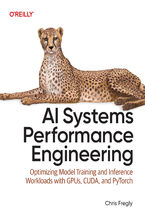 Elevate your AI system performance capabilities with this definitive guide to maximizing efficiency across every layer of your AI infrastructure. In today's era of ever-growing generative models, AI Systems Performance Engineering provides engineers, researchers, and developers with a hands-on set of actionable optimization strategies. Learn to co-
Elevate your AI system performance capabilities with this definitive guide to maximizing efficiency across every layer of your AI infrastructure. In today's era of ever-growing generative models, AI Systems Performance Engineering provides engineers, researchers, and developers with a hands-on set of actionable optimization strategies. Learn to co--
-
ebook
279 pkt
(271,15 zł najniższa cena z 30 dni)
279.65 zł
329.00 zł (-15%) -
-
Promocja
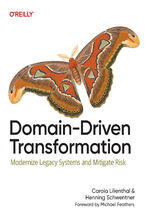 To prepare legacy software for the future, it's essential to modernize it. Domain-Driven Transformation provides an effective approach for transforming large legacy systems—either by breaking them into microservices or by converting them into maintainable modular monoliths. In this guide, Carola Lilienthal and Henning Schwentner present their metho
To prepare legacy software for the future, it's essential to modernize it. Domain-Driven Transformation provides an effective approach for transforming large legacy systems—either by breaking them into microservices or by converting them into maintainable modular monoliths. In this guide, Carola Lilienthal and Henning Schwentner present their metho-
-
ebook
203 pkt
(194,65 zł najniższa cena z 30 dni)
203.15 zł
239.00 zł (-15%) -
-
Promocja
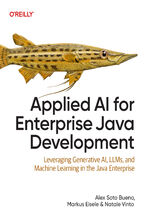 As a Java enterprise developer or architect, you know that embracing AI isn't just optional—it's critical to keeping your competitive edge. The question is, how can you skillfully incorporate these groundbreaking AI technologies into your applications without getting mired in complexity? Enter this clear-cut, no-nonsense guide to integrating genera
As a Java enterprise developer or architect, you know that embracing AI isn't just optional—it's critical to keeping your competitive edge. The question is, how can you skillfully incorporate these groundbreaking AI technologies into your applications without getting mired in complexity? Enter this clear-cut, no-nonsense guide to integrating genera-
-
ebook
186 pkt
(177,65 zł najniższa cena z 30 dni)
186.15 zł
219.00 zł (-15%) -
-
Promocja
 Get up to speed on a new unified approach to building machine learning (ML) systems with a feature store. Using this practical book, data scientists and ML engineers will learn in detail how to develop and operate batch, real-time, and agentic ML systems. Author Jim Dowling introduces fundamental principles and practices for developing, testing, an
Get up to speed on a new unified approach to building machine learning (ML) systems with a feature store. Using this practical book, data scientists and ML engineers will learn in detail how to develop and operate batch, real-time, and agentic ML systems. Author Jim Dowling introduces fundamental principles and practices for developing, testing, an-
-
ebook
228 pkt
(211,65 zł najniższa cena z 30 dni)
228.65 zł
269.00 zł (-15%) -
-
Promocja
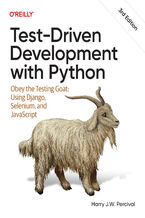 The third edition of this trusted guide demonstrates the practical advantages of test-driven development (TDD) with Python and describes how to develop a real web application. You'll learn how to write and run tests before building each part of your app and then develop the minimum amount of code required to pass those tests. The result? Clean code
The third edition of this trusted guide demonstrates the practical advantages of test-driven development (TDD) with Python and describes how to develop a real web application. You'll learn how to write and run tests before building each part of your app and then develop the minimum amount of code required to pass those tests. The result? Clean code-
-
ebook
228 pkt
(211,65 zł najniższa cena z 30 dni)
228.65 zł
269.00 zł (-15%) -
-
Promocja
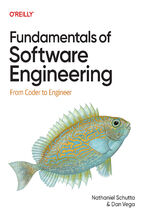 What do you need to know to be a successful software engineer? Undergraduate curricula and bootcamps may teach the fundamentals of algorithms and writing code, but they rarely cover topics vital to your career advancement. With this practical book, you'll learn the skills you need to succeed and thrive. Authors Nathaniel Schutta and Dan Vega guide
What do you need to know to be a successful software engineer? Undergraduate curricula and bootcamps may teach the fundamentals of algorithms and writing code, but they rarely cover topics vital to your career advancement. With this practical book, you'll learn the skills you need to succeed and thrive. Authors Nathaniel Schutta and Dan Vega guide-
-
ebook
186 pkt
(177,65 zł najniższa cena z 30 dni)
186.15 zł
219.00 zł (-15%) -
-
Promocja
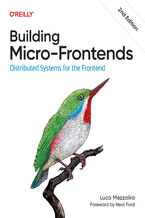 Is your frontend slowing down innovation and complicating team collaboration? Consider micro-frontends—a practical way to break development silos and accelerate feature delivery. In this updated second edition, software architects, tech leads, and software developers will learn how to design, build, and deploy independent micro-frontends that compo
Is your frontend slowing down innovation and complicating team collaboration? Consider micro-frontends—a practical way to break development silos and accelerate feature delivery. In this updated second edition, software architects, tech leads, and software developers will learn how to design, build, and deploy independent micro-frontends that compo-
-
ebook
203 pkt
(194,65 zł najniższa cena z 30 dni)
203.15 zł
239.00 zł (-15%) -
Dzięki opcji "Druk na żądanie" do sprzedaży wracają tytuły Grupy Helion, które cieszyły sie dużym zainteresowaniem, a których nakład został wyprzedany.
Dla naszych Czytelników wydrukowaliśmy dodatkową pulę egzemplarzy w technice druku cyfrowego.
Co powinieneś wiedzieć o usłudze "Druk na żądanie":
- usługa obejmuje tylko widoczną poniżej listę tytułów, którą na bieżąco aktualizujemy;
- cena książki może być wyższa od początkowej ceny detalicznej, co jest spowodowane kosztami druku cyfrowego (wyższymi niż koszty tradycyjnego druku offsetowego). Obowiązująca cena jest zawsze podawana na stronie WWW książki;
- zawartość książki wraz z dodatkami (płyta CD, DVD) odpowiada jej pierwotnemu wydaniu i jest w pełni komplementarna;
- usługa nie obejmuje książek w kolorze.
Masz pytanie o konkretny tytuł? Napisz do nas: sklep@ebookpoint.pl
Książka drukowana









Oceny i opinie klientów: Linux Security Cookbook Daniel J. Barrett, Richard E. Silverman, Robert G. Byrnes
(0)